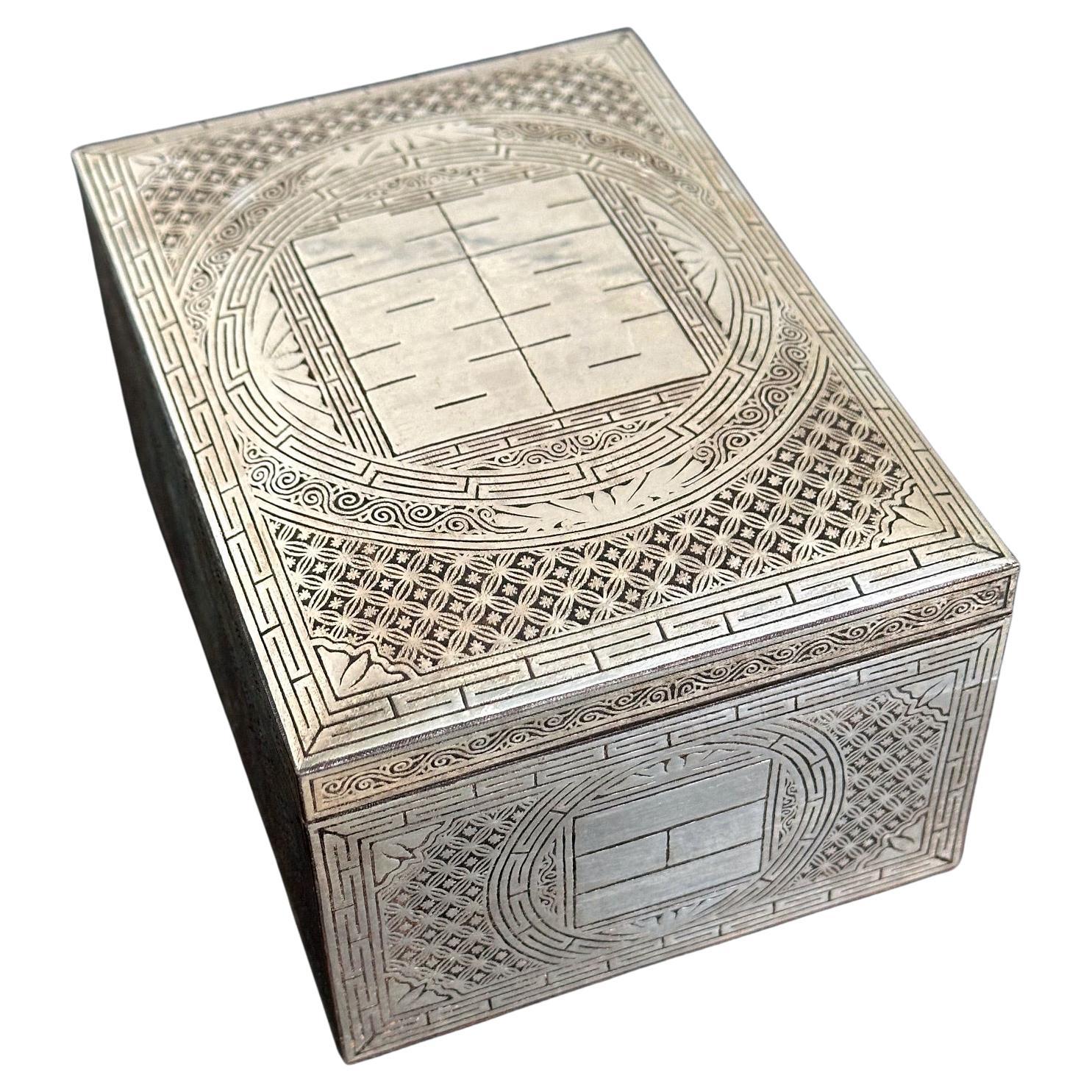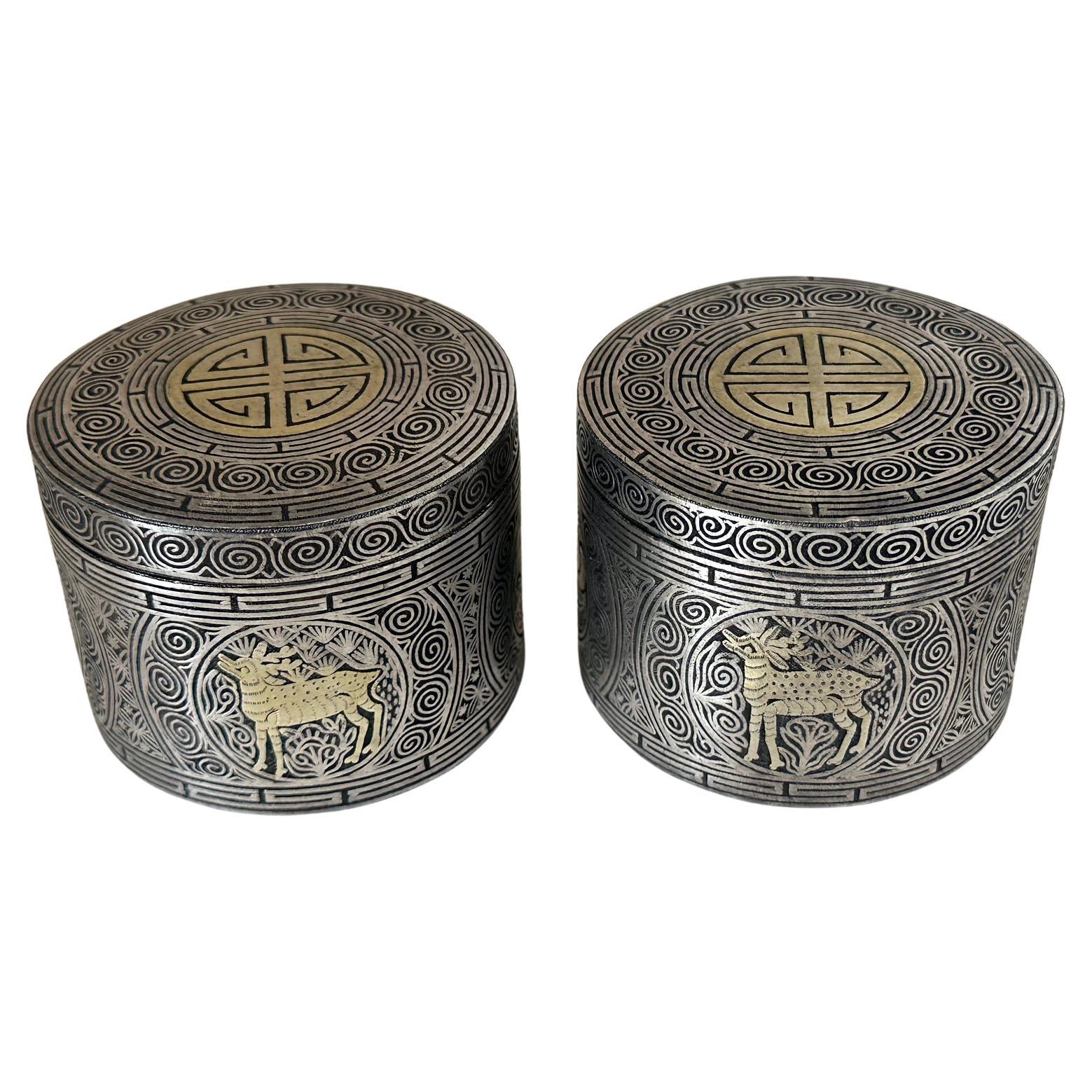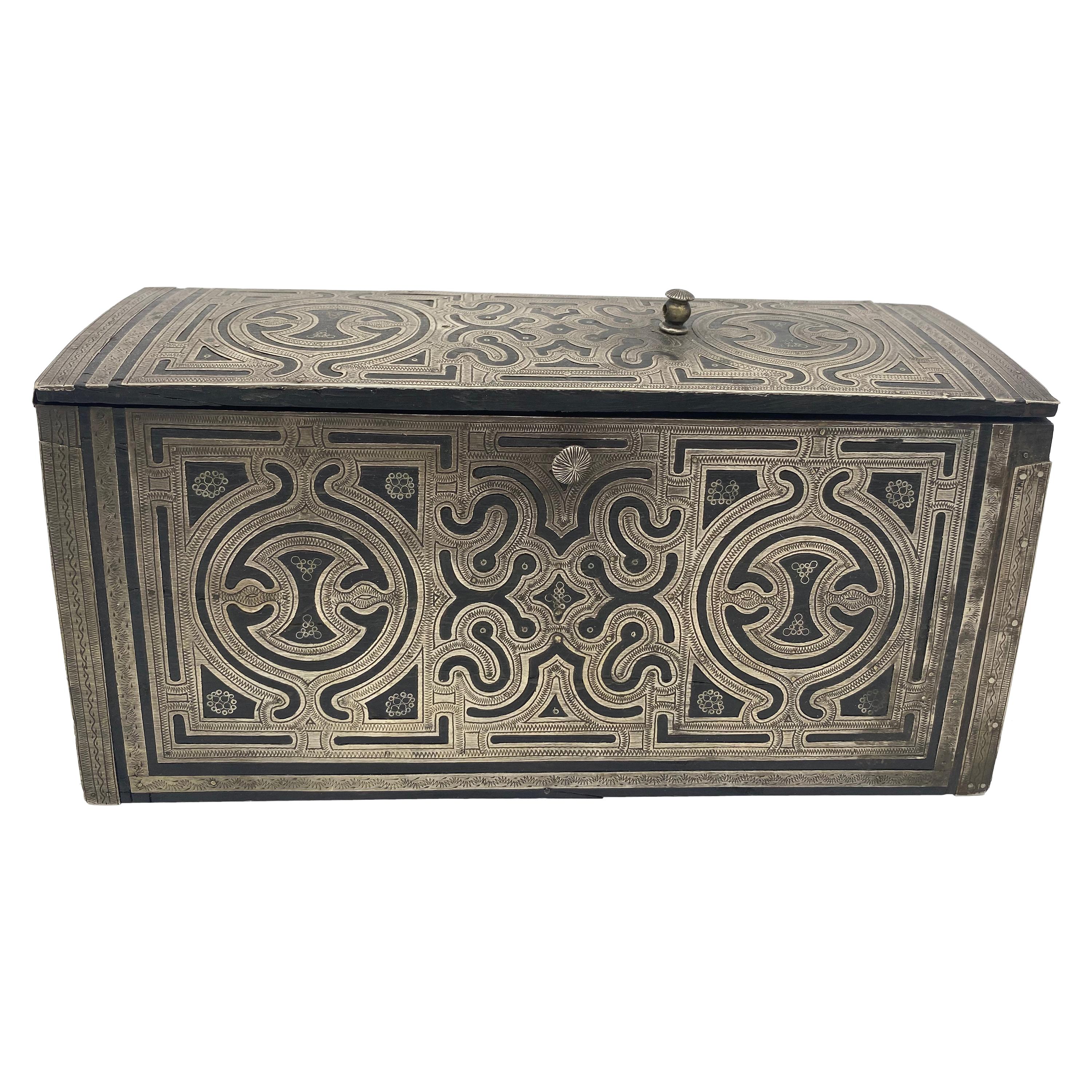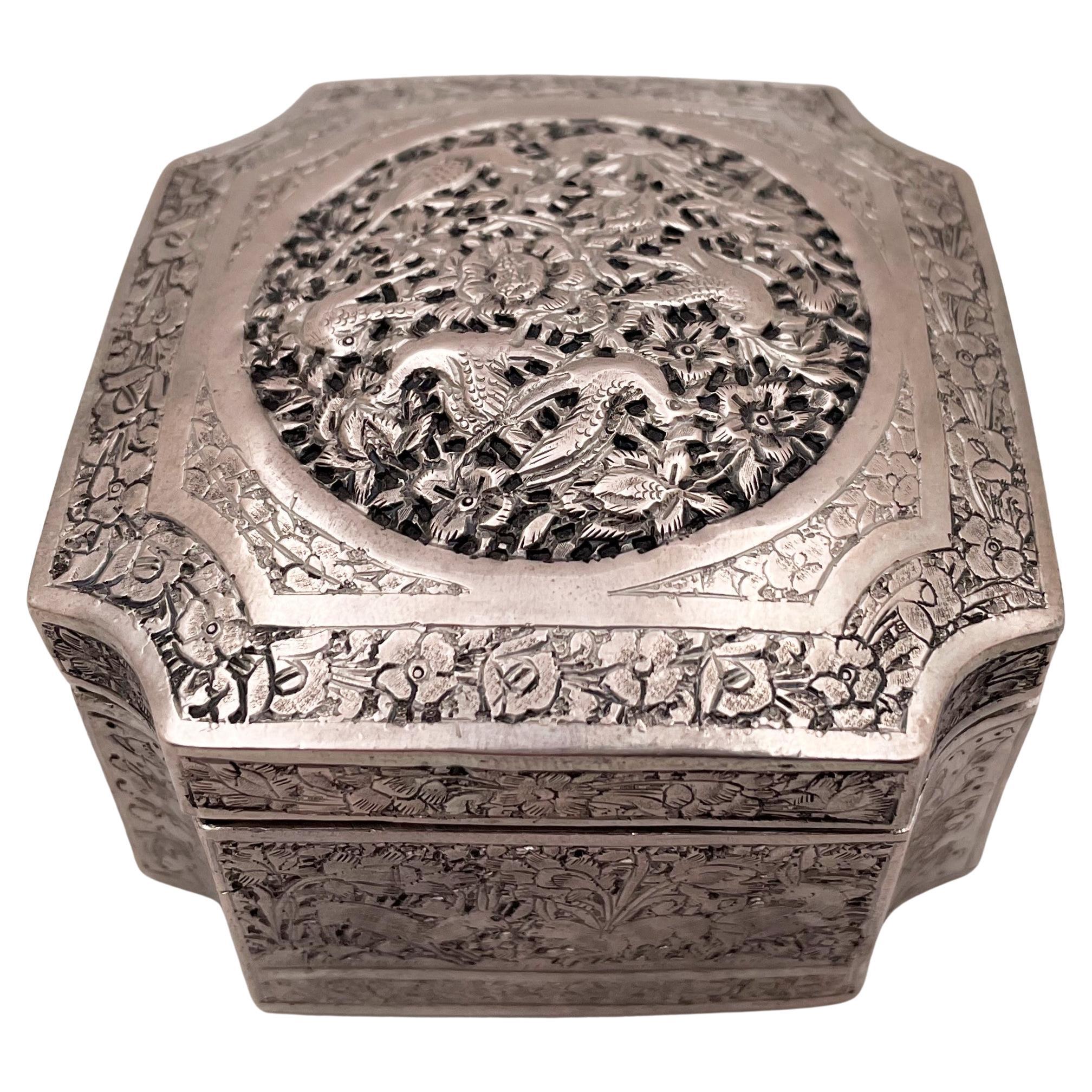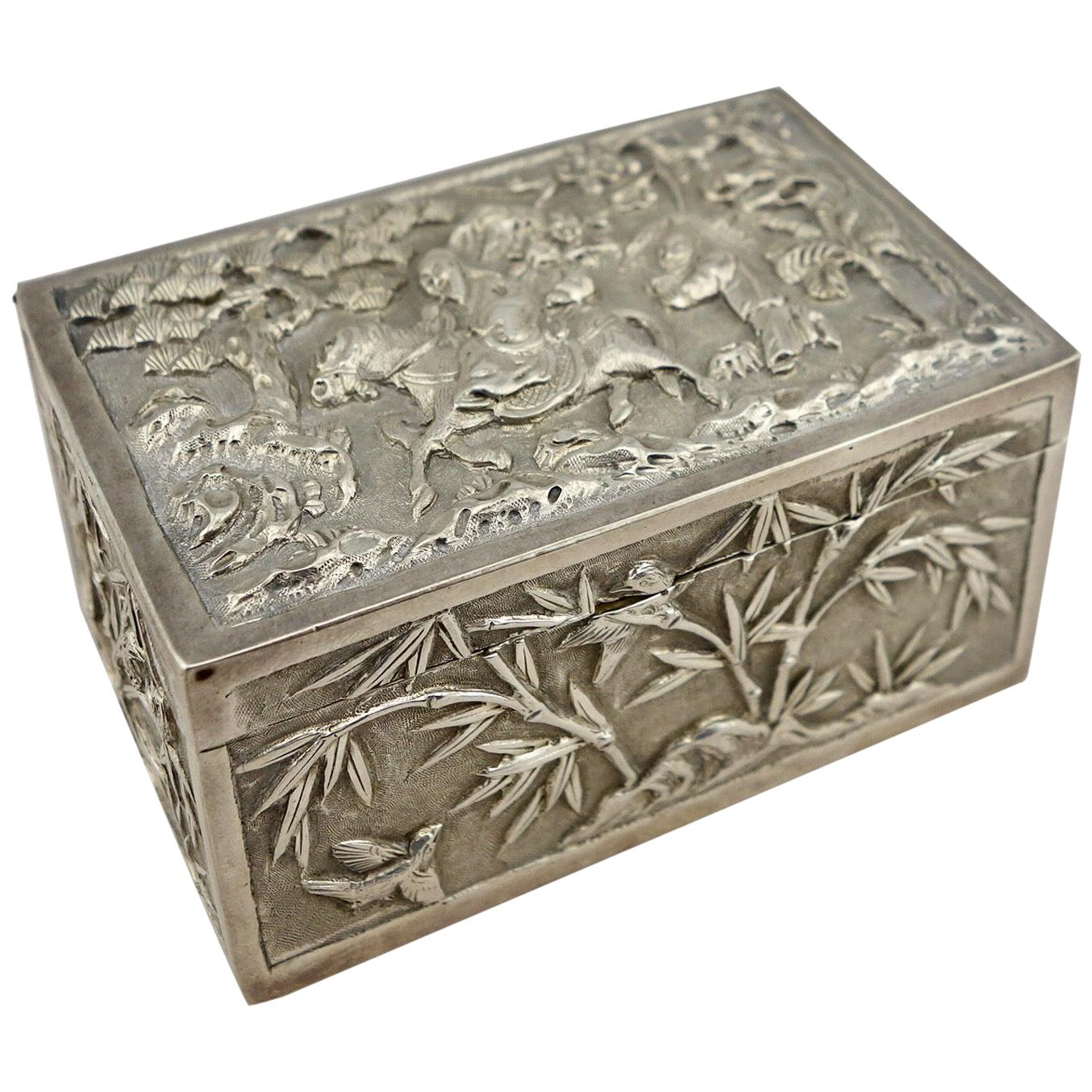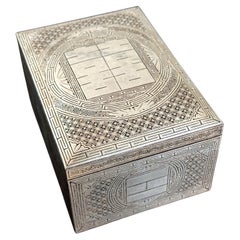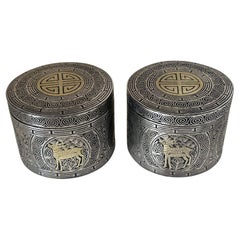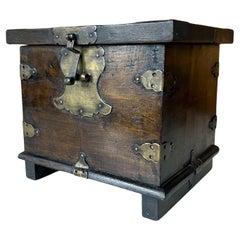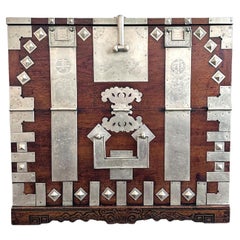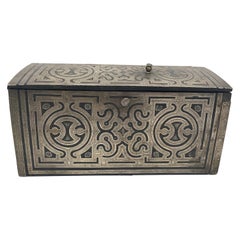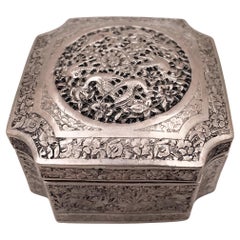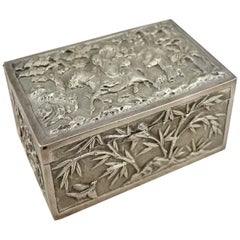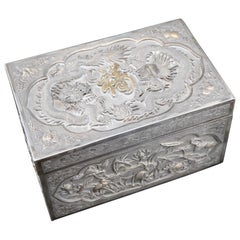Items Similar to Fine Korean Iron Box with Silver Inlay Joseon Dynasty
Want more images or videos?
Request additional images or videos from the seller
1 of 21
Fine Korean Iron Box with Silver Inlay Joseon Dynasty
$8,800
£6,728.07
€7,749.38
CA$12,331.50
A$13,766.96
CHF 7,213.68
MX$168,521.08
NOK 91,613.80
SEK 86,380.18
DKK 57,834.39
Shipping
Retrieving quote...The 1stDibs Promise:
Authenticity Guarantee,
Money-Back Guarantee,
24-Hour Cancellation
About the Item
A fine Korean iron box that was traditionally used to store tobacco leaves dated to the late Joseon Dynasty circa 19th century. The box is made from iron and has a heavy weight, although the wears along the edges of the lid and base exposes a bronze metal color underneath, indicating the iron metal may contains a high level of copper. The surface was beautifully decorated with elaborate silver inlay that covers the entire surface except the base. The extraordinary workmanship depicts a pair of deer within the circled square (shape of heaven and earth) and a lined background on the long sides and a crane with spread wings on the shorter sides. Both animals were associated with longevity. Their eyes were highlighted with copper inlay, adding a lively touch to the animation. The lid is centered with a Chinese character "Xi" (Paired-Hui in Korean), which means double happiness. (In Chinese culture, it is often used in a wedding ceremony). The large symbol was set on geometrical background of tightly scrolling diamond pattern surrounded by stylized Ruyi mushroom heads, another floral longevity symbol. Archaic fret cloud band borders the entire perimeters of the lid and the container.
Tobacco was introduced to Korean in the first half of the 17th century and gradually gained popularity. When the tobacco was started being smoked in shredded form instead of rolled leaves, there rose the production of the smoking accessories, with some in fine quality as luxury items for the elite. The accoutrement such as this box is a fine example made in late Joseon dynasty, using extensive silver inlay, a technique called "jjoeum-ipsa", in which the silver wires were hammered into the scorched iron surface to create the elaborate design.
Similar boxes with variation of shape and motifs are in the collection of several major museums. Compare the box with item Gu 754 in the National Museum of Korea; item 22.78 in MET NYC and M.240:1, 2-1926 in V& A Museum in London. The most closely related example we found is item C232 in the collection of the Museum of East Asian Art, Cologne (see the last picture).
- Dimensions:Height: 3.25 in (8.26 cm)Width: 3.8 in (9.66 cm)Depth: 5.3 in (13.47 cm)
- Style:Other (Of the Period)
- Materials and Techniques:
- Place of Origin:
- Period:
- Date of Manufacture:19th century
- Condition:Wear consistent with age and use. Minor losses. Fine example with expected patina from age and use, minor scattered losses of silver wear, darkened interior as shown.
- Seller Location:Atlanta, GA
- Reference Number:1stDibs: LU945032565932
About the Seller
4.9
Platinum Seller
Premium sellers with a 4.7+ rating and 24-hour response times
Established in 2006
1stDibs seller since 2010
564 sales on 1stDibs
Typical response time: <1 hour
- ShippingRetrieving quote...Shipping from: Atlanta, GA
- Return Policy
Authenticity Guarantee
In the unlikely event there’s an issue with an item’s authenticity, contact us within 1 year for a full refund. DetailsMoney-Back Guarantee
If your item is not as described, is damaged in transit, or does not arrive, contact us within 7 days for a full refund. Details24-Hour Cancellation
You have a 24-hour grace period in which to reconsider your purchase, with no questions asked.Vetted Professional Sellers
Our world-class sellers must adhere to strict standards for service and quality, maintaining the integrity of our listings.Price-Match Guarantee
If you find that a seller listed the same item for a lower price elsewhere, we’ll match it.Trusted Global Delivery
Our best-in-class carrier network provides specialized shipping options worldwide, including custom delivery.More From This Seller
View AllFine Korean Box with Tray Iron with Silver Inlay Joseon Dynasty
Located in Atlanta, GA
A fine Korean iron box with intricate silver inlay dated to the late Joseon Dynasty circa 19th century. The body of the box is made from iron of a heavy weight although the wear on t...
Category
Antique 19th Century Korean Other Metalwork
Materials
Silver, Iron
Pair Korean Iron Box with Silver Inlays Joseon Dynasty
Located in Atlanta, GA
A fine pair of Korean iron box with intricate silver inlays dated to the late Joseon Dynasty circa 19th century. The matching circular boxes was most likely used to store tobacco lea...
Category
Antique 19th Century Korean Other Metalwork
Materials
Silver, Iron, Bronze
Antique Korean Small Wood Box Joseon Dynasty
Located in Atlanta, GA
A small Korean antique box circa late 19th century of Joseon Dynasty. The square form box was constructed with thick hardwood planks on all side (appears to be elm) with a noticeable...
Category
Antique 19th Century Korean Other Furniture
Materials
Brass
Antique Korean Wedding Bandaji Chest Pyongyang Joseon Dynasty
Located in Atlanta, GA
A striking Korean wedding Bandaji with beautiful original condition and patina circa 19th century of late Joseon Dynasty. Bandaji is known as drop front half-opening chest that was u...
Category
Antique 19th Century Korean Other Furniture
Materials
Metal
Antique Korean Bandaji Chest Pyongyang Joseon Dynasty
Located in Atlanta, GA
Bandaji is known as drop front half-opening chest that was used to store family valuables and beddings. The Bandaji on offer was made in Pyongyang region of Pyongan Do (province) in ...
Category
Antique 19th Century Korean Other Furniture
Materials
Brass
Antique Korean Bandaji Chest Pyongyang Joseon Dynasty
Located in Atlanta, GA
A striking Bandaji from Nothern part of the Korean peninsula circa 19th century of late Joseon Dynasty. Bandaji is known as drop front half-opening chest that was used in traditional...
Category
Antique 19th Century Korean Other Furniture
Materials
Metal
You May Also Like
Antique Silver Outer Layer Wood Box
Located in Brea, CA
Antique silver outer layer on wood box. Extremely beautiful and very hard to find with intricate geometrical designs. Top of box width is 3 in. Bottom of box width is 4.5 in. See image.
Category
Antique 19th Century Decorative Boxes
Materials
Silver
Chinese Silver Box with Bird and Floral Motifs
Located in New York, NY
Chinese silver box, with an intricate design showcasing birds, floral, and other natural motifs, measuring 2 7/8'' by 2 7/8'' by 1 7/8'' in height.
Please feel free to ask us any q...
Category
Early 20th Century Chinese Decorative Boxes
Materials
Silver
Chinese Export Silver Repousse Scenic Box by Wang Hing, circa 1870
By Wang Hing & Co.
Located in Sarasota, FL
Chinese export silver repousse scenic box, depicting traditional scene of a mandarin riding his horse on the cover. The sides are decorated with stylized plant pattern. Marked "90" f...
Category
Antique 19th Century Chinese Other Metalwork
Materials
Silver
Chinese Export Silver Repousse Dragon and Landscape Box
Located in Sarasota, FL
Chinese silver box with repousse, chasing and cast applied dragons. Very fine period work. Marked with French import hallmarks.
Category
Antique Late 19th Century Chinese Chinese Export Metalwork
Materials
Silver
Chinese export tea chest with etched pewter insert
Located in Summerland, CA
This is a rare early 19th-century (c.1820) Chinese antique large lacquered gilt tea chest, containing an original pewter tea caddy liner. The chest is beautifully decorated with vil...
Category
Antique 1820s Chinese Qing Tea Caddies
Materials
Lacquer
Antique Southeast Asian Filipino Maranao Silver Inlaid Brass Betel Nut Box
Located in Forney, TX
A scarce fine quality antique silver-inlaid solid brass betel nut box (Lutuan), dating to the second half of the 19th / early 20th century, hand-crafted in Mindanao, Philippines.
Boxes such as this were used to store the areca nut (also known as the betel nut) which would be wrapped in a betel leaf with lime paste and other ingredients, often tobacco, for chewing. Similar to the European tea caddy, these boxes often served as a way to impress while showing off ones wealth.
Betel chewing was prevalent in the southern Philippines as in much of the rest of Southeast Asia. Wealthier Maranao families on Mindanao were able to afford elaborate silver-inlaid brass betel boxes such as this example. Such boxes were used to show off to guests and from which they were offered betel and the other component such as leaves and lime to make up the betel quid.
Rare large size, most extant examples of such boxes tend to measure around 5 inches in length. At slightly more than 7.75 inches the example here is larger than most.
The distinctive decorative box features a very heavy strong-box like rectangular shaped chest form with canted corners, copper handles, and a conforming hinged lid, lifting open to reveal an interior divided into three compartments covered by four hinged lids. Each of these doors is inlaid with silver in stylized orchid flower patterns.
Exceptionally executed throughout, the arabesque silver inlaid exterior is decorated to the top with a large orchid motif within scrolling obid-obid (stylized rope) borders. The front, back and sides are inlaid with sets of stylized tail feathers of the sari-manok bird beneath which are unusual, highly stylized whimsical zoomorphic faces that appear like cat or tiger faces. (Such stylisation is accounted for by Southeast Asian Islamic preferences to avoid the overt and this potentially idolatrous representation of animal and human forms. Designs such as these are drawn from a local design repertoire that has its origins in wood carving.
Although the spread of Islam in the Philippines began in the 14th century, mostly through the influence of Muslim merchants from the western Malay Archipelago, decorative arts in this design remain exceptionally rare. This lutuan represents a fine example of Islamic metalwork from the most eastern outreach of Islamic art and civilisation: Mindanao island being significantly further east than even China – artwork from Islamic Southeast Asia remains chronically under-represented in the world’s major collections of Islamic art.
PROVENANCE / ACQUISITION
Acquired from highly reputable auction house, Austin Auction Gallery, established 1983, Austin, Texas.
References
Brownrigg, H., Betel Cutters...
Category
Antique 19th Century Philippine Islamic Decorative Boxes
Materials
Silver, Brass, Bronze, Copper
More Ways To Browse
Antique Iron Collection
Antique Iron Box
Copper Inlay
Chinese Inlay Furniture
Korean Traditional Furniture
Metal Inlay Box
Chinese Metal Box
Copper And Silver Inlay
Antique Tobacco Color
Korea Box
17th Century London Silver
Antique Bronze Deer
Double Happiness
Chinese Scroll Box
Crane Box
Antique Smoking Accessories
Chinese Double Happiness
Mushroom Diamond
